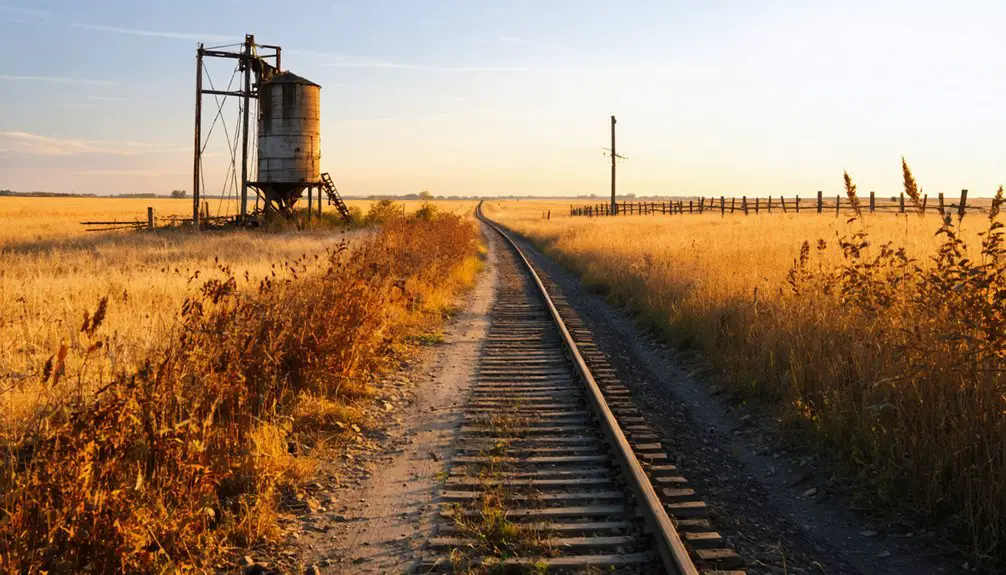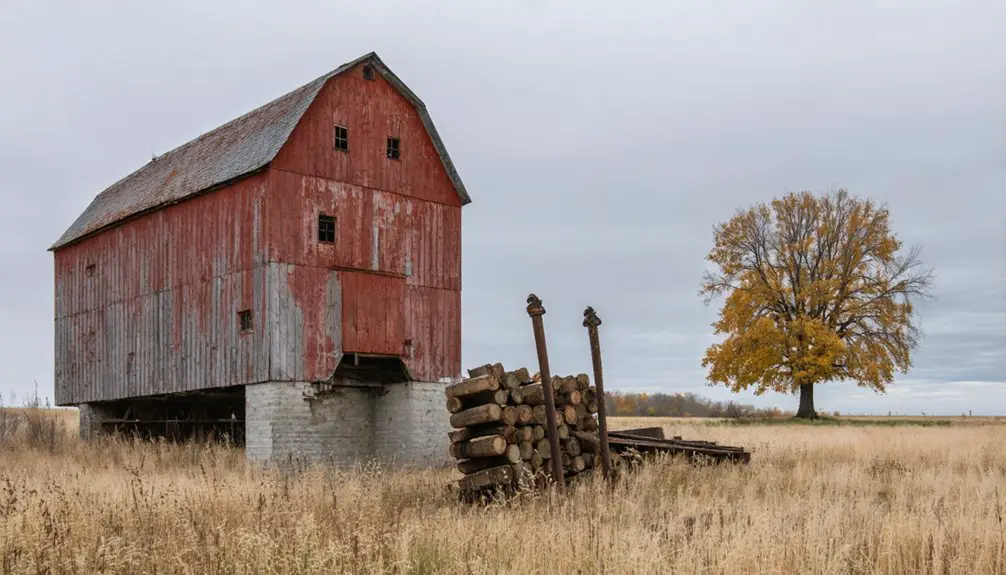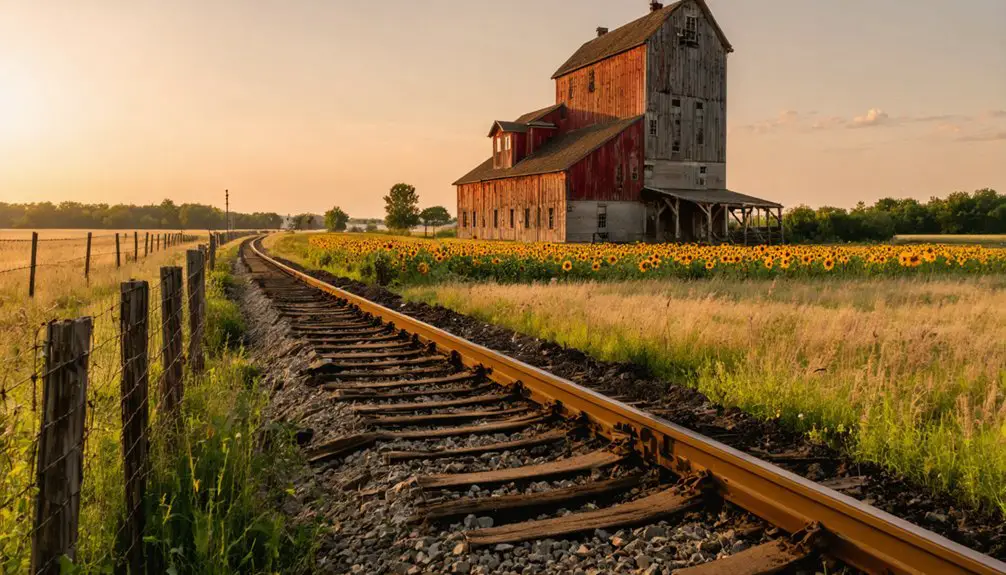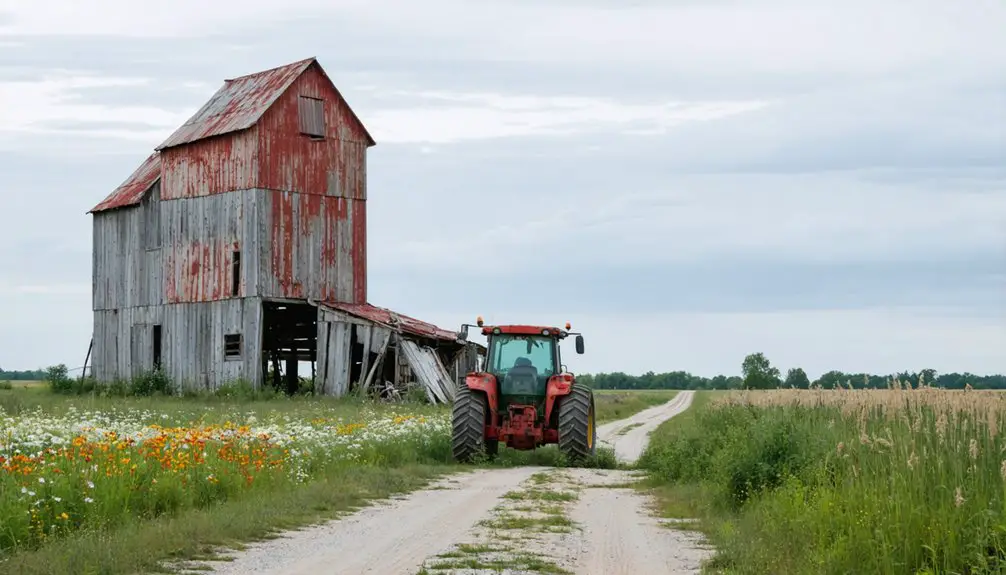You’ll find Garen’s ghost town remains along U.S. Highway 61 south of Forest Lake, where a tight-knit farming community once thrived. In 1863, forty-seven pioneering families cultivated 511 acres, establishing a bustling settlement complete with general stores, a schoolhouse, and logging operations that produced over 100,000 cords annually. While most structures have vanished into the forest, scattered foundations, cellar holes, and a well-maintained cemetery hold countless stories of this forgotten Minnesota town.
Key Takeaways
- Garen began as a thriving farming community along U.S. Highway 61 near Forest Lake, established by 47 pioneer families in 1863.
- The town’s economy centered around agriculture, logging operations, and local trading, producing 100,000 cords of timber annually at its peak.
- Railroad companies bypassed Garen for larger routes, leading to economic decline as commerce shifted to better-connected towns.
- Young residents moved to cities while farms consolidated, triggering closure of essential businesses and community services.
- Today, Garen stands nearly empty with only scattered foundations, cellar holes, and a maintained cemetery marking its existence.
The Rise and Settlement of Garen
While many Minnesota settlements emerged during the mid-1800s, Garen established itself as a modest farming community just south of Forest Lake along what’s now U.S. Highway 61.
You’ll find that settler experiences centered around agricultural pursuits, with 47 pioneering families cultivating 511 acres by 1863.
Similar to Forestville’s early days, the area saw an influx of over 100,000 settlers within its first decade of establishment.
The community dynamics developed around key transportation routes, including the old stage line from St. Paul to Duluth, which brought steady growth to the area.
The historic stage route between St. Paul and Duluth shaped Garen’s growth, making it a vital stop along this important transportation corridor.
Early settlers like Louis Schiel, a German immigrant, carved out homesteads and contributed to Garen’s development. Like many communities of the era, it was common for families to establish tight-knit communities that supported each other through the challenges of frontier life.
The strategic location made it an ideal spot for farming families seeking to establish roots, and they quickly built the foundations of a tight-knit community with essential amenities, including a schoolhouse that served as their social center.
Economic Foundations and Local Industries
You’d find Garen’s economy centered primarily around agriculture, with local farmers working the land and trading their harvests at the small general stores that dotted the community.
These family-run businesses served as crucial hubs where you could purchase essential supplies and exchange news while conducting trade. Similar to Forestville’s example, residents often relied on a store credit system for their transactions. The Oliver Iron Mining Company supported local agriculture by providing community gardens to employee families.
While the town’s location near Forest Lake and U.S. Route 61 provided decent market access for agricultural goods, Garen’s exclusion from the expanding railroad network ultimately limited its growth potential.
Agricultural Production and Trade
Throughout Garen’s early history, agriculture formed the bedrock of local economic activity, with wheat serving as the dominant cash crop until the late 1870s.
When soil depletion and crop diseases hit the region, you’d have seen local farmers embrace crop diversification, adding corn, oats, and potatoes to their fields. They didn’t just stick to crops – they raised livestock too, keeping cattle, pigs, and poultry as insurance against tough times. Early farmers relied heavily on horse-drawn binders and mowing machines to harvest their crops.
The arrival of the railroad changed everything, connecting Garen’s farmers to bigger markets in Minneapolis and St. Paul. Most farmers started their days at 4:00 am to prepare their produce for the journey to market.
Local families joined cooperative farming movements to fight back against unfair prices from railroads and grain merchants. You’d have found them working together through co-ops, sharing resources and collectively marketing their products to guarantee better returns for everyone.
Local Business Operations
A pair of powerful economic forces shaped Garen’s business landscape: the logging industry and its company-controlled structure. You’d find strict company governance controlling every aspect of local commerce, from the general store to worker housing. Much like the Erie Mining Company at Taconite Harbor, these operations maintained tight control over their workers’ lives.
The logging operation’s dominance meant producing over 100,000 cords annually at its peak, employing enough workers to support 250 residents. Like many towns of the era, Garen’s fate was heavily influenced by railroad routes that transported timber.
- The mill company regulated all business activities, similar to Minnesota’s mining towns
- Underground economies emerged through “blind pigs” selling illegal alcohol
- Local stores and services operated primarily to support logging workers
- Mail delivery services kept Garen connected despite its isolation
The town’s business model thrived until federal restrictions near the BWCA limited timber access, ultimately leading to the mill’s closure in 1964 and Garen’s abandonment.
Transportation and Market Access
Moving beyond the company-controlled business operations, Garen’s economic success hinged on its transportation networks.
During winter months especially, vital road access proved as crucial here as it did for towns like Cassville, Missouri.
You’d find stagecoaches running multiple times weekly, connecting you to Vernon Center and other villages, while trains delivered mail and goods to nearby Lake Crystal. The ox teams you’d spot hauling freight set the standard for travel times across rural Minnesota in those days.
Transportation innovations like plank roads and bridges in the Minnesota River Valley opened new possibilities for trade, though not all planned projects came to fruition. With the town’s location 40 miles from Ely, accessing major markets required significant time and effort.
The arrival of railroads transformed market accessibility, letting you ship goods faster than ever before.
But when rail routes changed and road infrastructure remained primitive, Garen’s isolation grew. Those dirt roads, barely passable in poor weather, ultimately contributed to the town’s decline.
Daily Life in Early Garen
Life in early Garen centered around the Garen South School, which served as both an educational institution and community hub after its establishment in 1893. You’d find mothers bringing hot soups and scalloped potatoes during harsh Minnesota winters, warming children’s cold lunches on the school’s oil stove.
Community gatherings strengthened the bonds between neighbors who relied on each other to survive and thrive.
- Wood-frame homes dotted the rural landscape, heated by wood or coal stoves
- Daily routines revolved around farming, with seasonal work shaping everyone’s lives
- You’d travel by foot or horse along dirt paths to reach neighbors or fields
- School meals became social events, with treats like hot chocolate bringing warmth to winter days
The town’s self-sufficient spirit showed in their gardens, shared meals, and cooperative approach to daily challenges.
Transportation Networks and Trade Routes

While Garen’s early settlers relied heavily on foot travel and horse-drawn wagons, the town’s commercial lifeline depended on a network of stagecoach and rail connections.
Early pioneers in Garen moved by foot and wagon, but the town thrived through its vital stagecoach and railway links.
You’d find thrice-weekly stagecoaches rolling into Vernon Center back in 1892, carrying mail, passengers, and news from the outside world.
The transportation evolution shaped Garen’s trade dynamics considerably. You could track goods moving through an intricate system connecting nearby settlements like Little Cobb and Cream, with trains running to Lake Crystal serving as crucial arteries for commerce.
The region’s trade routes followed ancient Native American paths, adapting to the landscape’s natural features. When you consider how mail delivery combined rail and Pony Express services to Myrna, it’s clear that Garen’s prosperity hinged on this multi-modal transport web until its eventual decline.
Factors Leading to Abandonment
If you’d visited Garen in its declining years, you would’ve seen how changes in railroad routes gradually pulled commerce away from this once-bustling farming community.
Local businesses struggled to survive as agricultural trends shifted and transportation patterns favored larger regional centers.
The closure of essential services like the general store and grain elevator marked critical turning points, making it increasingly difficult for remaining residents to sustain their daily lives.
Railroad Route Changes
As railroad companies reassessed their networks in the late 19th and early 20th centuries, major carriers like the Great Northern and Northern Pacific Railway began prioritizing their transcontinental mainlines over smaller branch operations.
Railroad economics drove decisions to optimize routes, leaving towns like Garen behind as companies sought more profitable corridors.
- Logging railroads, once essential to the region, disappeared after timber resources were depleted.
- Competition from highways reduced the need for local rail stops.
- Route optimization favored towns with larger commercial significance.
- Corporate mergers, especially the 1970 Great Northern-Northern Pacific consolidation, eliminated redundant lines.
You’ll find that Garen’s switch line, primarily serving agricultural shipments and cattle transport, couldn’t justify its maintenance costs as freight traffic dwindled and the economics of rail transport evolved.
Local Business Closures
When local farms began consolidating in the mid-20th century, Garen’s business district faced a devastating chain reaction of closures.
You’d have seen the town’s economic resilience crumble as fewer farmers meant fewer customers for the general stores, cattle pens, and equipment shops. The Half-Way Inn, once bustling with travelers, couldn’t sustain itself as automobiles bypassed the town center for newer highways.
The shifting demographics dealt another blow to business sustainability. As young folks moved to cities for better opportunities, you wouldn’t find enough customers to keep shops profitable.
The remaining aging population couldn’t support diverse commerce, and when community anchors like schools shuttered, the social fabric that held local businesses together unraveled.
Even the underground bootlegging economy, which briefly sustained some activity, vanished with Prohibition’s end.
Remaining Structures and Landmarks

The ghost town of Garen stands nearly empty today, with almost no original structures remaining from its days as an active settlement.
You’ll find only scattered foundations and cellar holes where homes and businesses once thrived. While nature has reclaimed most of the landscape, the town’s cemetery serves as the last preserved landmark, offering glimpses into the lives of early settlers through weathered gravestones.
- No standing residential or commercial buildings survive
- A maintained cemetery preserves family names and local history
- Old roadbeds and pathways are barely visible through forest growth
- Archaeological fragments occasionally surface, telling tales of past life
If you’re exploring the site, you’ll need to rely on your imagination, as there aren’t any historical markers to guide you through Garen’s vanished streets.
The forest and prairie have transformed the once-bustling town into a quiet memorial to Minnesota’s past.
Historical Significance in Carver County
Beyond the scattered ruins, Garen’s story embodies a larger narrative of pioneer ambition and settlement challenges in Carver County.
You’ll find in Garen’s rise and fall a reflection of how settlement patterns shaped Minnesota’s river valleys during the mid-1800s. After the Treaty of Traverse Des Sioux opened the land, ambitious settlers staked their claims along the Minnesota River, hoping to build prosperous communities.
Yet Garen’s history reveals the economic challenges that many river towns faced. While some settlements thrived with railroad connections, Garen struggled against flooding, transportation bottlenecks, and declining river commerce.
Prosperity eluded many river settlements as they battled nature’s fury and watched vital rail lines bypass their communities.
When the railroads bypassed the town, you could say it sealed Garen’s fate. Today, it’s an illustration of the delicate balance between opportunity and survival in Minnesota’s pioneer era.
Legacy and Modern-Day Preservation

Despite its physical decline, Garen’s legacy lives on through dedicated preservation efforts and cultural memory.
You’ll find that local historical societies have taken the lead in documenting the town’s story, preserving not just buildings but the rich tapestry of lives that once called this place home. The economic shifts that led to Garen’s abandonment mirror the broader story of rural Minnesota’s transformation.
- Walking trails now wind through the former townsite, offering glimpses into the past
- Local historians maintain archives of photographs and personal accounts
- Educational programs bring schoolchildren to learn about rural migration patterns
- Preservation efforts focus on stabilizing remaining structures while respecting private property rights
These preservation initiatives guarantee that Garen’s story continues to resonate with new generations, reminding us how changing times reshape our communities.
Frequently Asked Questions
Were There Any Documented Supernatural Occurrences or Local Legends About Garen?
You won’t find documented ghostly sightings or local folklore about this place – the records show it was simply a farming community that faded away due to economic changes, nothing supernatural.
What Happened to the Cemetery and Burial Records From Garen?
You’ll find the cemetery’s precious records split between Minnesota Genealogical Society archives and township files since 1965, though burial site preservation remains incomplete, with some early graves lost to time’s march.
Did Any Famous Individuals or Notable Historical Figures Visit Garen?
You won’t find records of any famous historical visitors or notable residents in Garen’s history. Unlike other Minnesota ghost towns that attracted political figures, Garen’s limited documentation doesn’t mention any prominent personalities.
What Native American Tribes Originally Inhabited the Area Before Garen’s Establishment?
You’ll find the Dakota Sioux were the primary inhabitants, with Ojibwe tribes also claiming presence in the region. Both peoples left their mark through hunting grounds and spiritual connections to the land.
Were There Any Major Criminal Incidents or Law Enforcement Challenges in Garen?
While you might expect a crime-filled past, Garen itself had no major criminal incidents. You’ll find the law enforcement challenges were centered around Forest Lake, with bootlegging and organized crime operating nearby.
References
- https://www.startribune.com/ghost-towns-minnesota-nininger-forestville-old-crow-wing/601169483
- https://racketmn.com/ghost-towns-minnesota-hennepin-county
- https://www3.mnhs.org/mnopedia/search/index/place/ghost-towns-carver-county
- https://www.youtube.com/watch?v=5bCG6B2rzZY
- https://www.carvercountyhistoricalsociety.org/ghost_towns.php
- https://exploringnorthshore.com/north-shore-ghost-towns/
- https://www.mngoodage.com/voices/mn-history/2019/07/a-ghost-town-turned-history-site/
- https://blueearthcountyhistory.com/2020/09/23/ghost-towns-in-blue-earth-county/
- https://www.wchsmn.org/forest-lake/
- https://wikipedia.nucleos.com/viewer/wikipedia_en_all/A/Garen



